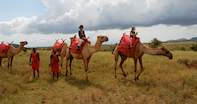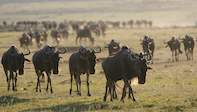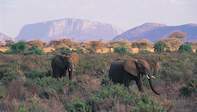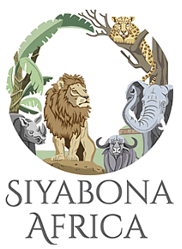
Learn more about Kenya National Parks and Reserves, from the popular Masai Mara National Reserve to the smaller and lesser-known Kenya national parks.
Aberdare National Park
Covering 766km², the Aberdares are a densely wooded mountain range rising to over 4000m with magnificent views over nearby Mount Kenya to the north, and the Rift Valley to the south. The mountain slopes are covered in dense stands of rare Afro-montane forest, while the high grasslands feature Afro-Alpine and sub-Alpine heath and groundsels.
The vistas are often more like those of Scotland than of Africa. A number of crystal clear streams and rivers, all stocked with rainbow trout, criss cross the plateau, with some spectacular waterfalls as the rivers tumble off the escarpment.
The plateau is rich in game, with Elephant, Leopard, Lion, Giant Forest Hog, Bushbuck, Blue Monkey, Colobus Monkey, Black Rhino, Buffalo and Suni being some of the characteristic species. Lucky visitors may catch a glimpse of the rare melanistic (pitch black) strain of Leopard.
This is one of the last strongholds of the critically endangered bongo. Walking is allowed, but only with an armed guard, as the Lions here are aggressive and there have been several attacks in the past.
Learn more about Aberdare National Park
Amboseli National Park
A small park by Kenyan standards, covering just under 400sq km at the center of the border with Tanzania, 220km (136.7 miles) from Nairobi. The view of the Amboseli plains, with elephant moving below the snow-capped peaks of Mount Kilimanjaro, is one of the most photographed vistas in Africa.
A network of swamps and wetlands ensure excellent game viewing year-round. There are 425 recorded bird and 56 mammal species in the park, including Lion, Leopard, Cheetah, Elephant, Hippo, Black Rhino, Maasai Giraffe, Gerenuk, and Zebra.
Learn more about Amboseli National Park
Laikipia Plateau
Situated between the north Kenya deserts and the Aberdare Mountains, the Laikipia Plateau stretches from Mount Kenya to the edge of the Great Rift Valley. Made famous by Kuki Gallman in her book , I Dreamed of Africa, the region is home to some of the most luxurious camps in Kenya.
'The place, teeming with wildlife, green with pastures, rolling hills, rivers and springs, appeared as a mirage to the weary traveller.' Kuki Gallman, I Dreamed of Africa. Predators, including the rare caracal, and plains game are abundant and where it is possible a night drive, provides the opportunity to see the shy aardvark and aardwolf.
Masai Mara National Reserve
390km (242.3) from Nairobi in the southwest corner of the country, lies a vast rolling plain beneath the Mara escarpment striped black once a year by millions of Wildebeest and Zebra migrating north from the Serengeti plains. During the migration season (July / August) the reserve's resident lions lounge prominently in the sun, fat and seemingly placid. There are 13 tented camps and 2 lodges in the reserve.
Maasai tribes people live on the reserve's fringes and are co-owners of the reserve, sharing in revenues from tourism. This 1 672km² reserve is one of Africa's premier wildlife destinations, and boasts all the big game species. Besides the normal safari activities, it is also possible to go hot air ballooning across the plains, one of the finest ways to see Africa's wildlife.
Learn more about Masai Mara National Reserve

Meru National Park
400km from Nairobi, this 870km² park is one of Kenya's most remote and unspoilt, being way off the beaten, package tourism track. The park was made famous by George and Joy Adamson as the place to which they brought Boy, son of the lioness, Elsa ('Born Free'), to set him free. Here too, Joy trained the cheetah, Pippa, in how to re-adapt to the wild (as told in 'The Spotted Sphinx').
The Tana River, the largest in Kenya, abuts a small section of the park in the east, and Adamson's Falls, at the tip of the park, are a spectacular sight after rain. Besides all the usual big game species (rhino excluded) this is an excellent place to see two relatively unusual animals, reticulated Giraffe and Gerenuk, also known as Giraffe-necked Gazelle.
White Rhino were reintroduced here, but fell prey to the guns of poachers in 1988. Since then, security has been considerably tightened up, and poaching has all but ceased.
Learn more about Meru National Park
Mount Kenya National Park
Home to Kenya's highest mountain and Africa's second highest mountain Mount Kenya (1,600m-5,199m), Mount Kenya National Park is situated approximately 193km's (119.9 miles) North-East of Nairobi and is located in the central highlands in the districts of Nyeri and Meru.
The entire area of the park is situated above 3,200m. Straddling the equator, Mount Kenya's icy peaks reach an altitude of 5,100m. Due to it's unique position astride the equator, a unique and bizarre species of Giant Rosette like plant flourish.
These plants are commonly known as 'water holding cabbage', 'ostrich plume plant' or 'giant groundsel' and are quite an astonishing sight when seen for the first time. The vegetation in general consists of rich alpine and sub-alpine flora with montane and bamboo forests, moorlands and tundra.
The giant forest hog, tree hyrax, white-tailed mongoose, elephant, black rhino, suni, duiker and leopard all occur in the lower forest and bamboo forest areas. In the moorland regions mammals such as the Mount Kenya mouse shrew, hyrax and duiker occur.
At higher altitudes the endemic mole-rat is common and there have been rare sightings of the golden cat. Elephant, Buffalo, Antelope, Lion and the rare bongo can all be seen in the regions below the Park boundary. The south side of the mountain is the best place for wildlife viewing.
The best times of the year to visit this region are January, February and late August through to September.
Learn more about Mount Kenya National Park
Nairobi and Surrounds
Nairobi is one of Africa's major cities with a population of between one and a half million and three million, depending on how big an area you include. A century old in 1999, the city has an interesting history. Nairobi began as a settlement created to build the East African railway line from Mombasa to Kampala in Uganda.
The name came from the local Maasai word for the area, enkare nyarobi, meaning 'the place of cold water'. A few years later the settlement was completely rebuilt due to the outbreak of plague and the subsequent burning of the original town.
By 1907 the area had become firmly established and colonised with the settlement of Europeans and subsequently became the capital of 'British East Africa'. In general, visitors spend no more than two nights in town before heading off on safari.
The initial impression of the city is one of frenetic chaos, with the driving in general leaving a lot to be desired. However there is a considerable amount to do and see while there.
Learn more about Nairobi
Samburu National Park
Samburu National Park is situated in the hot arid northern region of Kenya 325km's (201.9 miles) from Nairobi, 90km's (55.9 miles) north of Mount Kenya. The park covers an area of 165 sq kilometres. The Ewaso Ngiro River, which rises in the Aberdares runs through the park resulting in a permanent water source.
While the wildlife experience in Samburu is not as exciting as many of the southern parks, Samburu's scenic beauty more than makes up for this. Due to the constant abundance of water the banks of the river are lined with rich riverine woodland vegetation. Acacia woodland with bushland, grassland and scrubland all occur in this region.
The reserve is home to a number of animal species rarely found elsewhere. Among these are the Grevy's zebra, reticulated Giraffe, Somali Ostrich, gerenuk and the Beisa Oryx, all of which are only found north of the equator. Samburu's birdlife is diverse and prolific.
Crocodiles occur in abundance and can be seen at virtually every bend on the Ewaso Ngiro River's sand banks. Further downstream where permanent pools have formed, hippo's are a common sight. Elephants roam the scrubland regions and seek solace in the shallow waters of the Ewaso Ngiro. Due to poaching, Rhino sadly no longer occurs in the reserve.
Learn mroe about Samburu National Park

Tsavo National Park
At 21,000 sq km, this is Kenya's largest park by far, but much of the eastern section is closed to the public. Most of the land is open savannah and bush woodlands inhabited by Buffalo, Lion, Antelope, Gazelles, Giraffe and Zebra.
Despite a drastic fall in the elephant population in the 1970's there are still many large herds. Tsavo is a combination of dramatic escarpment landscapes combined with the raw, untamed flavour of one of Africa's great wilderness areas.
Mzima Springs, in Tsavo East, is one of the best places to watch crocodile and hippo. Here, crystal clear water bubbles out of the ground at a rate of 500-million litres (110-million gallons) a day. The spring is fed by snow melt off Mount Kilimanjaro, and a pipeline from the springs provides Mombasa with a large portion of its drinking water.
A distinctive feature of Mzima is an underwater glass cage built by a wildlife film crew. Here you can descend a set of stairs, and encased in a glass hide, watch shoals of tilapia, and the occasional Crocodile or Hippo glide by.
Learn more about Tsavo East and Tsavo West

 These Kenya safari holiday itineraries are based on the themed safari options allowing you to enjoy the best of what Kenya has to offer. The...
These Kenya safari holiday itineraries are based on the themed safari options allowing you to enjoy the best of what Kenya has to offer. The... Regional information on attractions of Kenya game reserves and national parks located throughout Kenya....
Regional information on attractions of Kenya game reserves and national parks located throughout Kenya....